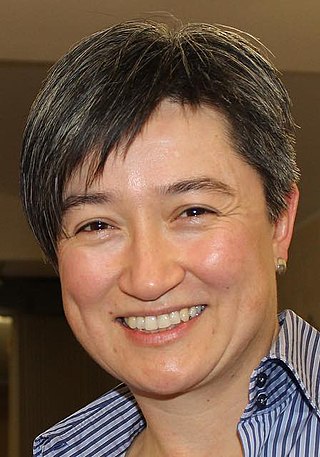
A prime minister,premier or chief of cabinet is the head of the cabinet and the leader of the ministers in the executive branch of government, often in a parliamentary or semi-presidential system. Under those systems, a prime minister is not the head of state, but rather the head of government, serving under either a monarch in a democratic constitutional monarchy or under a president in a republican form of government.

The prime minister of Australia is the head of government of the Commonwealth of Australia. The prime minister heads the executive branch of the federal government of Australia and is also accountable to federal parliament under the principles of responsible government. The current prime minister is Anthony Albanese of the Australian Labor Party, who became prime minister on 23 May 2022.

The prime minister of Canada is the head of government of Canada. Under the Westminster system, the prime minister governs with the confidence of a majority of the elected House of Commons; as such, the prime minister typically sits as a member of Parliament (MP) and leads the largest party or a coalition of parties. As first minister, the prime minister selects ministers to form the Cabinet and chairs it. Constitutionally, the Crown exercises executive power on the advice of the Cabinet, which is collectively responsible to the House of Commons.

The Westminster system or Westminster model is a type of parliamentary government that incorporates a series of procedures for operating a legislature. This concept was first developed in England.
A presidency is an administration or the executive, the collective administrative and governmental entity that exists around an office of president of a state or nation. Although often the executive branch of government, and often personified by a single elected person who holds the office of "president", in practice, the presidency includes a much larger collective of people, such as chiefs of staff, advisers and other bureaucrats. Although often led by a single person, presidencies can also be of a collective nature, such as the presidency of the European Union is held on a rotating basis by the various national governments of the member states. Alternatively, the term presidency can also be applied to the governing authority of some churches, and may even refer to the holder of a non-governmental office of president in a corporation, business, charity, university, etc. or the institutional arrangement around them. For example, "the presidency of the Red Cross refused to support his idea." Rules and support to discourage vicarious liability leading to unnecessary pressure and the early termination of term have not been clarified. These may not be as yet supported by state let initiatives. Contributory liability and fraud may be the two most common ways to become removed from term of office and/or to prevent re-election.
The Cabinet of Canada is a body of ministers of the Crown that, along with the Canadian monarch, and within the tenets of the Westminster system, forms the government of Canada. Chaired by the prime minister, the Cabinet is a committee of the King's Privy Council for Canada and the senior echelon of the Ministry, the membership of the Cabinet and ministry often being co-terminal; as of November 2015 there were no members of the latter who were not also members of the former.
A cabinet secretary is usually a senior official who provides services and advice to a cabinet of ministers as part of the Cabinet Office. In many countries, the position can have considerably wider functions and powers, including general responsibility for the entire civil service.

The deputy prime minister of Australia is the deputy chief executive and the second highest ranking officer of the Australian Government. The office of deputy prime minister was officially created as a ministerial portfolio in 1968, although the title had been used informally for many years previously. The deputy prime minister is appointed by the governor-general on the advice of the prime minister. When Australia has a Labor government, the deputy leader of the parliamentary party holds the position of deputy prime minister. When Australia has a Coalition government, the Coalition Agreement mandates that all Coalition members support the leader of the Liberal Party becoming prime minister and mandates that the leader of the National Party be selected as deputy prime minister.

The Minister for Foreign Affairs is the minister in the Government of Australia who is responsible for overseeing the international diplomacy section of the Department of Foreign Affairs and Trade. Senator Penny Wong was appointed as Foreign Minister in the ministry led by Prime Minister Anthony Albanese in May 2022 following the 2022 Australian federal election. As the first female foreign minister from the Australian Labor Party, Wong also became the third female foreign minister in a row, following Julie Bishop and Marise Payne. The Foreign Minister is one of two cabinet-level portfolio ministers under the Department of Foreign Affairs and Trade, the other being the Minister for Trade and Tourism Senator Don Farrell.
The Cabinet of Australia is the chief decision-making organ of the executive branch of the government of Australia. It is a council of senior government ministers, ultimately responsible to the Federal Parliament.
In Canada from 1993 to 2003 and again from 2007 to 2008, secretary of state was a title given to junior ministers of state in the Government of Canada that sat outside Cabinet. Because it was a position that was assigned to assist Cabinet ministers, a secretary of state was legally a minister of state; the distinction is that, unlike a minister, a secretary is not a full cabinet portfolio itself and thus not considered a member of Cabinet. The Secretary of State , for instance, would assist the Minister for Human Resources and Development. This usage is opposite to that in the United Kingdom, where junior ministers generally report to more senior secretaries of state. Secretaries of state were, however, members of the ministry and the Queen's Privy Council for Canada.
A minister of state is a junior cabinet minister in the Cabinet of Canada, usually given specific responsibilities to assist a senior cabinet minister in a specific area. A secretary of state also holds many similar responsibilities in assisting senior cabinet members, being members of the Ministry and the Queen's Privy Council for Canada. A secretary of state is legally a minister of state styled as secretaries. However, secretaries of state are considered junior to ministers of state and are not members of Cabinet.
A private secretary (PS) is a civil servant in a governmental department or ministry, responsible to a secretary of state or minister; or a public servant in a royal household, responsible to a member of the royal family.

The government of France, officially the Government of the French Republic, exercises executive power in France. It is composed of the Prime Minister, who is the head of government, as well as both senior and junior ministers. The Council of Ministers, the main executive organ of the government, was established in the Constitution in 1958. Its members meet weekly at the Élysée Palace in Paris. The meetings are presided over by the President of France, the head of state, although the officeholder is not a member of the government.
The title secretary of state or state's secretary is commonly used for senior or mid-level posts in governments around the world. The role varies between countries, and in some cases there are multiple secretaries of state in the country's system of governing the country.

The Leader of the Government in the Senate is the government's most senior cabinet minister in the Australian Senate and the main government spokesperson in the Senate. His or her Opposition counterpart is the Leader of the Opposition in the Senate.

The first Turnbull ministry was the 69th ministry of the Government of Australia, led by Prime Minister Malcolm Turnbull. It succeeded the Abbott ministry after a leadership spill that took place on 14 September 2015 ended Prime Minister Tony Abbott's leadership of the Liberal Party of Australia. On 15 September, the National Party confirmed, after successful negotiations, that it would continue a coalition agreement with the Liberal Party, guaranteeing the Turnbull Government a majority in the Australian House of Representatives.

The second Turnbull ministry was the 70th ministry of the Government of Australia, led by Prime Minister Malcolm Turnbull. It succeeded the first Turnbull ministry following the 2016 Australian federal election on 2 July 2016.

Cabinet Secretary is a ministerial portfolio within the Australian federal government. It has existed in three periods, from 2007 to 2013, from 2015 to 2017, and since 2022. The minister is responsible for assisting the Prime Minister of Australia in managing the day-to-day procedural and operational matters of the Cabinet and any Cabinet committees. The Cabinet Secretary's portfolio falls within the Department of the Prime Minister and Cabinet.










